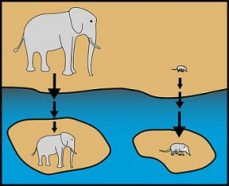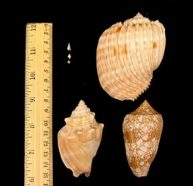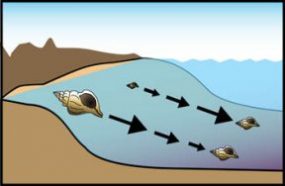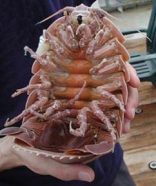Sea Giants and Island Pygmies
Food supply may help decide an animal's natural size on an island or in the ocean.
Share this:
- Share via email (Opens in new window) Email
- Click to share on Facebook (Opens in new window) Facebook
- Click to share on X (Opens in new window) X
- Click to share on Pinterest (Opens in new window) Pinterest
- Click to share on Reddit (Opens in new window) Reddit
- Share to Google Classroom (Opens in new window) Google Classroom
- Click to print (Opens in new window) Print
By Emily Sohn
The natural world is full of extremes. Elephants and whales are huge. Minnows and mice are small.
But it’s also possible to find pygmy elephants, enormous rodents, and giant squid. Such surprising size variations have sent scientists scrambling to understand why certain types of animals grow larger or smaller in some places than they do in others.
One place to find animals with unusual sizes is on an island. In such an isolated setting, creatures that are normally small, such as tortoises and rodents, tend to grow unusually large. Creatures that are normally large, such as deer and elephants, become unusually small.
 |
|
Large animals, such as elephants, may become smaller when isolated on islands. In contrast, relatively small animals, such as shrews, sometimes evolve into larger species.
|
| © 2006 MBARI |
The trend is so common that it has a name: the island rule. Scientists know that it happens, but they don’t yet know why.
The deep sea might hold the answer, says Craig McClain, a biologist at the Monterey Bay Aquarium Research Institute in Moss Landing, Calif.
According to McClain’s research, creatures that live thousands of feet below the surface of the ocean are also often noticeably smaller—or larger—than related species that live in shallow waters. A key reason could be food supply, he says.
Snail studies
McClain and his coworkers focused on snails. The scientists identified every snail genus (group of related species) that includes some species that live in shallow water and other species that live in deep water.
The scientists recorded the average body size of each of about 6,000 species of snails. Then, they looked for trends.
They found that snail species that live in the seas undergo the same types of changes as animal species on islands do. Snails that are large in shallow water get smaller in deep water, while snails that are small in shallow water get bigger in deep water.
 |
|
This photograph shows three medium-size shallow-water snails and three tiny deep-sea snails (upper left).
|
| © 2006 Craig McClain |
Scientists have proposed several theories to explain the island rule. For example, large animals might get smaller on islands because there’s less living space. The same area that supports only 5 ordinary-size elephants could allow, say, 20 small elephants to survive.
But there’s no such space crunch in the deep sea. There’s plenty of room.
As a second explanation, scientists have proposed that when on an island, animals have fewer predators than they do on the mainland. As a result, they can get bigger.
In the seas, however, predators appear to be just as active, if not more so, in the ocean depths as in shallow water.
So, the usual explanations for changes in animal size on islands—cramped living space and predators—don’t appear to apply to creatures that live in the sea.
Food supply
To explain both the island rule and the ocean results, McClain focuses on something that all animals need, regardless of their environment: an adequate food supply.
On islands, there’s less room for food than there is on continents. And only a tiny amount of food ever drifts into the dark, cold depths of the ocean.
 |
|
Large shallow-water snails tend to evolve into smaller species in deep water, while tiny snails often grow larger.
|
| © 2006 MBARI |
This food-based theory is unique, McClain says, because it explains both the shrinking of some species and expanding of others.
If food is scarce and you’re small, for example, getting bigger can help you travel farther for food and survive longer without eating. If food is scarce and you’re large, on the other hand, getting smaller can help you survive on less food.
“The thing that trips me out is being able to describe two completely different things simultaneously with one idea,” McClain says. “Science is about trying to keep it simple.”
Island rule
Experts are intrigued by the possibility that the island rule describes more than just islands.
“It extends a pattern way beyond what I initially thought existed,” says Mark Lomolino, a biologist at the State University of New York College of Environmental Science and Forestry in Syracuse. “When I began to study the island rule, I thought it just applied to mammals.”
 |
|
This giant deep-sea isopod has evolved to a much larger size in deeper water. These isopods are distant relatives of the tiny pill bugs found in many gardens. They are also related to small, shallow-water isopods that live in tide pools.
|
| National Oceanic and Atmospheric Administration (NOAA) |
Not everyone is convinced that food supply tells the whole story, and scientists continue to discuss other explanations.
To provide additional evidence for his own theory, McClain plans to look for similar patterns among squid, octopuses, clams, oysters, and other animals that may be sensitive to the amount of food in the environment.
No matter what McClain finds, he’s sure to have an interested audience. “Scientists look for fundamental rules about how nature is organized,” Lomolino says. “That’s probably why this is so alluring.”
Going Deeper:







